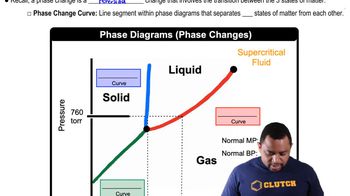The following equilibria were measured at 823 K: CoO(s) + H2(g) ⇌ Co(s) + H2O(g) Kc = 67 H2(g) + CO2(g) ⇌ CO(g) + H2O(g) Kc = 0.14 (a) Use these equilibria to calculate the equilibrium constant, Kc, for the reaction CoO(s) + CO(g) ⇌ Co(s) + CO2(g) at 823 K.
Ch.15 - Chemical Equilibrium
Chapter 15, Problem 98d
The phase diagram for SO2 is shown here. (d) At which of the three points marked in red does SO2(g) most closely approach ideal-gas behavior?

 Verified step by step guidance
Verified step by step guidance1
Identify the conditions under which a gas behaves ideally: low pressure and high temperature.
Examine the phase diagram and locate the points A, B, C, and D.
Determine the pressure and temperature at each point: A (low pressure, low temperature), B (low pressure, moderate temperature), C (moderate pressure, high temperature), D (high pressure, high temperature).
Compare the conditions at each point to the ideal gas conditions.
Conclude that the point with the lowest pressure and highest temperature is where SO2(g) most closely approaches ideal-gas behavior.

Verified video answer for a similar problem:
This video solution was recommended by our tutors as helpful for the problem above.
Video duration:
50sWas this helpful?
Key Concepts
Here are the essential concepts you must grasp in order to answer the question correctly.
Ideal Gas Behavior
Ideal gas behavior refers to the theoretical condition where a gas perfectly follows the ideal gas law (PV=nRT) without deviations. This occurs at high temperatures and low pressures, where intermolecular forces are negligible, and the volume of gas particles is insignificant compared to the volume of the container. Understanding this concept is crucial for identifying conditions under which real gases, like SO2, behave more like ideal gases.
Recommended video:
Guided course

Ideal Gas Law Formula
Phase Diagram
A phase diagram is a graphical representation that shows the phases of a substance (solid, liquid, gas) at various temperatures and pressures. It helps visualize the conditions under which a substance exists in different states and the transitions between these states. In the context of the question, the phase diagram for SO2 indicates the regions where the gas phase is stable and where it may exhibit ideal behavior.
Recommended video:
Guided course

Phase Changes in Diagrams
Critical Point
The critical point on a phase diagram marks the end of the liquid-gas phase boundary, beyond which the distinction between liquid and gas phases disappears. At this point, the substance exhibits unique properties, and the behavior of gases can deviate significantly from ideal conditions. Recognizing the critical point is essential for understanding where SO2 may approach ideal gas behavior, particularly in relation to the marked points in the diagram.
Recommended video:
Guided course

Boiling Point Elevation
Related Practice
Textbook Question
Textbook Question
The following equilibria were measured at 823 K: CoO(s) + H2(g) ⇌ Co(s) + H2O(g) Kc = 67 H2(g) + CO2(g) ⇌ CO(g) + H2O(g) Kc = 0.14 (d) If the reaction vessel from part (c) is heated to 823 K and allowed to come to equilibrium, how much CoO(s) remains?
2
views
Textbook Question
The phase diagram for SO2 is shown here. (e) At which of the three red points does SO2(g) behave least ideally?
Textbook Question
In Section 11.5, we defined the vapor pressure of a liquid in terms of an equilibrium. (a) Write the equation representing the equilibrium between liquid water and water vapor and the corresponding expression for Kp.
